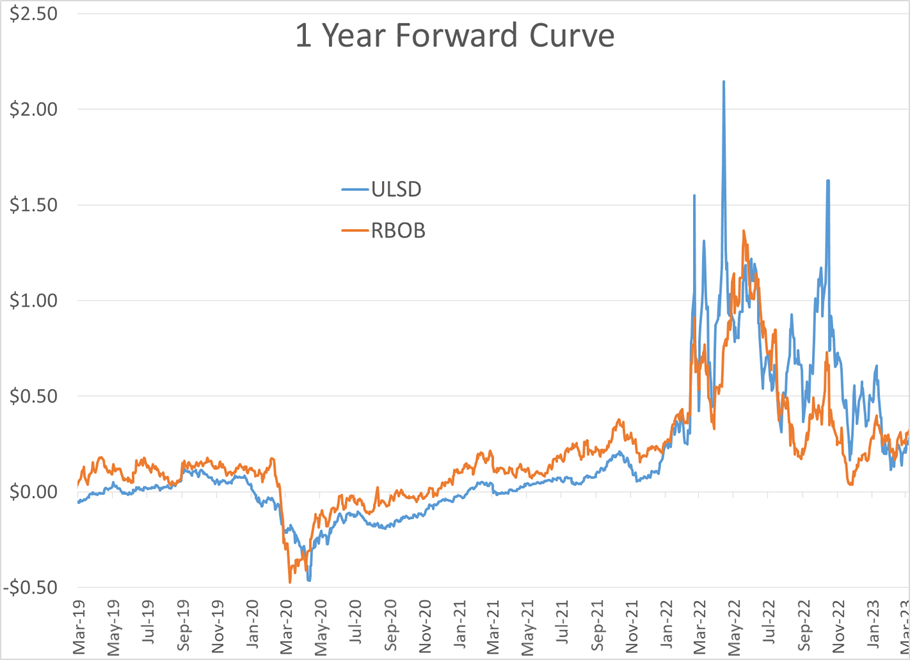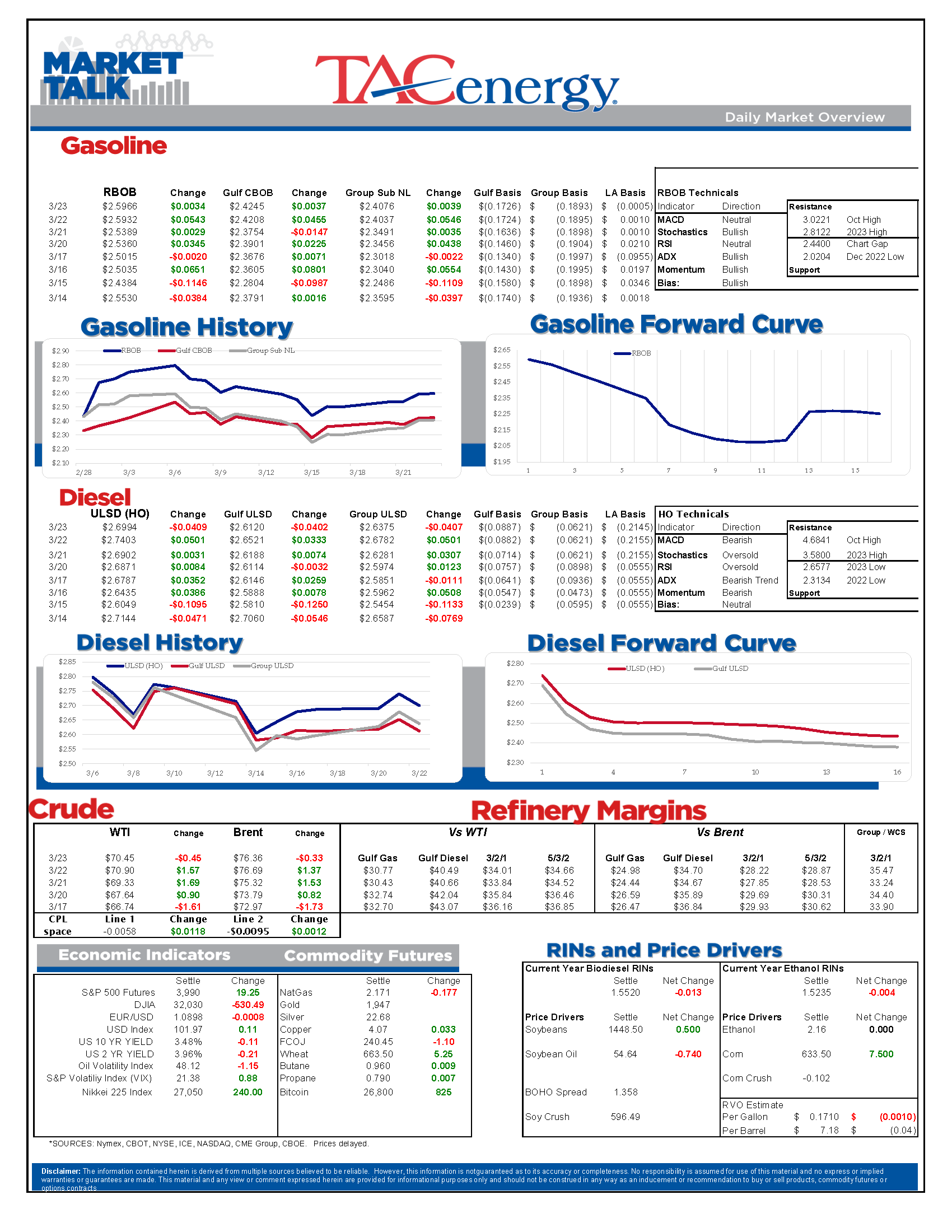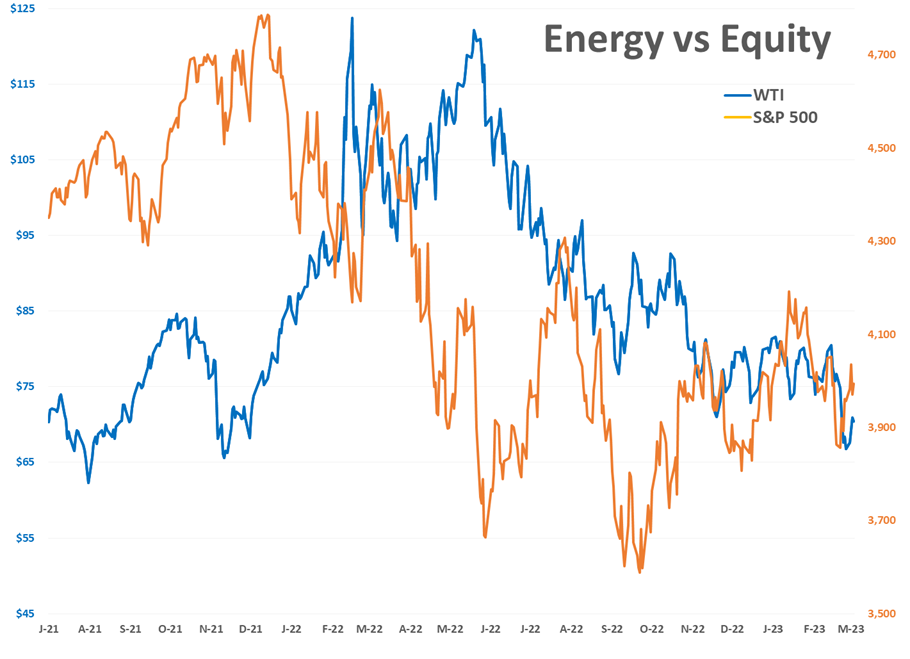FOMC Rate Increase Rocks Equity Markets, Energy Futures Unshaken

Stocks didn’t like the FOMC’s move to increase the fed funds rate by 25 points even as it acknowledged that recent banking developments will weigh on economic activity, or the economic projections that showed inflation expectations moving higher than previously forecast and had their worst day in 2 weeks following those announcements.
Even though energy and equity markets have seen their correlation strengthen in March following the banking crisis, the drop in equities did little to slow the recovery rally in energy that stretched to a third day Wednesday. We are seeing a more cautious start this morning with both WTI and ULSD seeing modest losses early, while RBOB continues to push higher for a 4th day.
Gasoline futures are seeming to get a small boost from reports that Monroe was forced to shut an FCC unit at its Trainer PA refinery following a fire Monday. As the charts below show, PADD 1 refinery runs are already at the low end of their seasonal range due to turnaround work at the P66 Bayway facility. Prices to ship products on Colonial have been trading in negative territory lately, and gasoline traders will not want to buy Gulf Coast barrels that have already transitioned to summer grades and bring them to the East Coast that still has a few weeks left to sell winter-grade product, but if this outage is extended, we could see that change next week.
Reports suggest 13% of French fueling stations are tight on supply due to the continuing refinery strikes, with some regions seeing as many as half of their stations out of fuel. The supply disruptions continue to get minimal reaction from global markets with only modest strengthening in time and crack spreads observed so far. A glut of distillates in Asia, as the Eastern hemisphere deals with an influx of Russian exports (aka the opposite problem the Western hemisphere had last year) is contributing to the lack of reaction to the latest supply disruption.
The EIA reported another 2 million barrels/day of crude oil inventory adjustments last week, while strong exports held domestic inventories steady despite another 14 million barrels being found. The agency also released its report on its findings for the rapidly growing adjustment, and its plan to update its weekly survey to help the data make more sense. The report admits that the agency has been inadvertently overstating domestic petroleum consumption, by counting light hydrocarbons and unfinished oils blended into crude as if they’ve been used by consumers, which explains the “record high” total demand even while refined products have seen declines in their figures.
Both gasoline and diesel demand did see healthy increases last week, marking a 2nd straight week of improving numbers for both. Diesel consumption is still at the low end of its seasonal range despite two weeks of growth in the EIA’s estimates, while gasoline is just below its 5-year average for this time of year. Retail prices for both are now approaching $1/gallon less than they were a year ago, which should help give a boost to consumption as we move further into spring.
PADD 5 refinery runs saw another healthy increase last week, and a tick up in imports, both of which might help explain the big declines in gasoline and diesel basis values we’ve seen in the past two weeks. In addition, Wednesday saw a pipeline deal for RD99 executed in the LA market, which will certainly be the first of many as that rapidly increasing supply comes to market. ULSD values did recover from Tuesday’s attempt to liquidate with no liquidity that briefly pushed values down a theoretical 45 cents for the day, although prompt values are still going for 20+ cent discounts to April futures.
The EIA did not yet report Exxon’s 250,000 barrel/day expansion at its Beaumont facility, even though those units have been running for several weeks now. The facility did report an upset in a hydrocracker unit Wednesday, although the impact of that event is still unclear.
Latest Posts
Markets Rallying To End The Week, Diesel Prices Lead The Way For Energy
Energy Markets Rally Again Thursday After A Choppy Wednesday Session
Week 16 - US DOE Inventory Recap
Energy Markets Trading Quietly In The Red As Ethanol Prices Rally To Five-Month High
Social Media
News & Views
View All
Markets Rallying To End The Week, Diesel Prices Lead The Way For Energy
Energy markets are rallying to end the week, with diesel prices leading the way up 2.5 cents in the early going. Equity markets are also rallying after a big Thursday selloff as strong tech earnings seem to be outweighing the FED’s favorite inflation gauge remaining stubbornly high.
RBOB gasoline futures are trading higher for a 4th straight day, but despite bouncing nearly 14 cents from Tuesday’s low, they still need to rally another nickel to break the downward sloping pattern forming on the weekly charts. Seasonal factors could go either way for gasoline for the next few weeks as we’re in the Spring peaking window, and while the high set April 12th would fit the annual pattern nicely, a May price peak is certainly not unusual, and if $2.85 is broken it seems like RBOB will run to $3 in a hurry.
Diesel prices have bounced 7 cents after touching a 5-month low on Monday but need to climb back above $2.60 to reduce the chance of a slide to $2.20 or lower should the chart support around $2.50 break down.
Back to the shadow war: After a relatively quiet few weeks in the Red Sea, Houthi attacks on ships have started again over the past few days, although so far, no major damage has been reported.
ExxonMobil reported another strong quarter in Q1 with more than $10 billion in free cash flow generated, even though earnings in its refining segment were down 67% from the first quarter of last year. The company noted the success of its Beaumont refinery expansion that came online last year and marked the only major refinery expansion in the US in over a decade. It's worth noting that within the refining segment, international earnings suffered more than domestic facilities did, with non-US refining earnings down 77% from a year ago as crack spreads came back to reality after the record-setting quarters in 2022 and 2023.
Chevron followed a similar pattern (as expected) in its Q1 report, noting strong operating cash flows of $6.8 billion in total, despite downstream earnings falling more than 56% for the quarter.
The company also highlighted its expanding marketing network along the US West and Gulf Coast markets encompassing more than 250 retail stations and highlighted its new solar-to-hydrogen project in California.
Phillips 66 continued the trend, reporting a “strong” quarter in which earnings were 63% lower than a year ago. The company highlighted the conversion of its Rodeo refinery which is now producing roughly 30mb/day of RD and is expected to ramp up to 50mb/day in the 2nd quarter. That facility had a capacity of more than 120mb/day prior to its conversion, and it used to produce gasoline along with its diesel. The company also noted its ongoing plans to sell assets that no longer fit its strategy, highlighting retail assets in Germany and Austria as being on the chopping block, while not mentioning any of its US refining assets that have long been rumored to be for sale.
Delek reported another upset at its Alon Big Spring refinery Thursday, which has become another one of the TCEQ’s frequent fliers after suffering damage from the cold snaps in both 2021 and earlier this year.
A harsh reality sinking in: Mexico’s President has made plenty of headlines with fictitious claims of energy sovereignty in the past few years, but not only is the country’s new Dos Bocas refinery still not producing finished products on any sort of meaningful scale, two of its other facilities have suffered fires recently forcing the country to import even more product from the US. This phenomenon continues to help US Gulf and West coast refiners who would be struggling (even more) to move their excess with sluggish domestic demand.
Click here to download a PDF of today's TACenergy Market Talk.

Energy Markets Rally Again Thursday After A Choppy Wednesday Session
Energy markets are trying to rally again Thursday after a choppy Wednesday session. RBOB gasoline futures are leading the push higher, on pace for a 3rd consecutive day of gains after finding a temporary floor Tuesday and have added 12 cents from those lows.
Equity markets are pointing sharply lower after a weak Q1 GDP estimate which seems to have contributed to a pullback in product prices over the past few minutes, but don’t be surprised if the “bad news is good news” low interest rate junkies start jumping in later on.
The DOE’s weekly report showed sluggish demand for gasoline and diesel, but inventory levels in most markets continue to follow their typical seasonal trends. Refinery runs held fairly steady last week with crude inputs down slightly but total gross throughputs up slightly as most facilities are now back online from a busy spring maintenance season and geared up for peak demand this summer.
Propane and propylene exports spiked to a record high north of 2.3 million barrels/day last week, which demonstrates both the US’s growing influence on global product markets, and the steady shift towards “other” products besides traditional gasoline and diesel in the level of importance for refiners.
The EIA acknowledged this morning that its weak diesel consumption estimates reflected the switch to Renewable Diesel on the West Coast, although they did not provide any timeline for when that data will be included in the weekly survey. The agency acknowledged that more than 4% of the total US consumption is now a combination of RD and Biodiesel, and that number is expected to continue to grow this year. This morning’s note also suggested that weak manufacturing activity was to blame for the sluggish diesel demand across the US, while other reports suggest the freight recession continued through Q1 of this year, which is also contributing to the big shift from tight diesel markets to oversupplied in several regions.
Valero kicked off the Q1 earnings releases for refiners with solid net income of $1.2 billion that’s a far cry from the spectacular earnings north of $3 billion in the first quarter of 2023. The refining sector made $1.7 billion, down from $4.1 billion last year. That is a pattern that should be expected from other refiners as well as the industry returns to a more normal market after 2 unbelievable years. You wouldn’t guess it by looking at stock prices for refiners though, as they continue to trade near record highs despite the more modest earnings.
Another pattern we’re likely to see continue with other refiners is that Renewable earnings were down, despite a big increase in production as lower subsidies like RINs and LCFS credit values sting producers that rely on those to compete with traditional products. Valero’s SAF conversion project at its Diamond Green joint venture is progressing ahead of schedule and will give the company optionality to flip between RD and SAF depending on how the economics of those two products shakes out this year. Valero also shows part of why refiners continue to disappear in California, with operating expenses for its West Coast segment nearly 2X that of the other regions it operates in.




